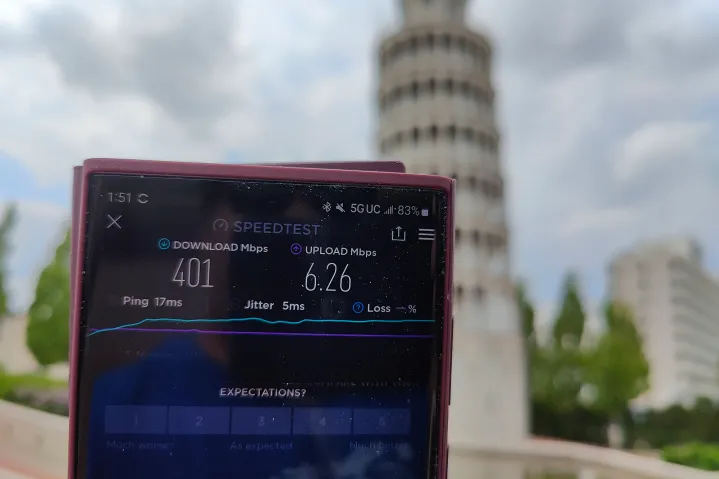It’s been 10 months since Verizon and AT&T flipped the switch on their new C-band 5G spectrum, but it appears both carriers still have their work cut out for them if they want to catch up to T-Mobile.
Market analyses and independent tests have agreed for years that T-Mobile is the fastest and most reliable 5G carrier in the U.S. That’s not surprising as it had a massive advantage by holding licenses for the crucial midrange spectrum that provides the best balance between range and speed. While Verizon’s early high-frequency mmWave rollouts allowed it to boast raw speeds that were significantly faster, those were confined to about 1% of its subscriber base.

However, when Verizon and AT&T wanted to deploy 5G outside of a few major cities, they were stuck using low-band 5G spectrum that was not only slower on its own, but also had to share the airwaves with 4G/LTE frequencies. Meanwhile, T-Mobile had a nice chunk of midband spectrum that it acquired from its 2020 merger with Sprint that was free and clear to drive its Ultra Capacity network.
T-Mobile still has a commanding lead
When Verizon and AT&T finally got their hands on the all-important C-band spectrum in 2021, many expected we’d soon see a more level playing field. In January 2022, Verizon began a nationwide rollout of its new spectrum, which could theoretically offer even faster performance than T-Mobile’s legacy midrange frequencies.
Nevertheless, while C-band showed impressive speed improvements, T-Mobile retained its commanding lead. A July report from Ookla showed that T-Mobile’s 5G and 4G/LTE networks were still nearly twice as fast as those of its rivals.
Today, Ookla released its latest third-quarter report, and the results are surprising mostly in what they don’t show. Despite AT&T and Verizon’s new C-band rollouts, T-Mobile remains the fastest mobile operator in the U.S. by a sizable margin; “Verizon Wireless and AT&T were distant runners up,” the report notes.
Specifically, T-Mobile showed a median download speed of 116.14Mbps. That’s nearly double Verizon’s 58.64Mbps and AT&T’s 57.94Mbps.

Those speeds remain largely unchanged from Ookla’s July report, where T-Mobile clocked in at 116.54Mbps, while Verizon and AT&T came in at 59.67Mbps and 54.64Mbps, respectively.
Similarly, T-Mobile maintained its lead for the highest median upload speeds, at 10.91Mbps, versus Verizon’s 8.3Mbps and AT&T’s 7.55Mbps. Again, those scores were consistent with the second-quarter 2022 numbers, which came in at 11.72Mbps, 9.14Mbps, and 7.00Mbps, respectively.
Looking purely at performance on the carriers’ 5G networks, the numbers also remained largely unchanged from July. T-Mobile still has a healthy lead with median 5G download speeds of 193.06Mbps, a slight increase over its previous 187.33Mbps score, but still in the same ballpark. Likewise, Verizon came in at 119.80Mbps versus 113.52Mbps in July, and AT&T jumped to 81.22Mbps from its 71.54Mbps score.
How does C-band fit in?
The new C-band spectrum only applies to 5G performance, and it shows in the improvements we’ve seen over the last year from Verizon and AT&T.
For instance, when Verizon turned the key on its C-band spectrum on January 19, it saw nationwide 5G performance jump by a staggering 52% practically overnight. The numbers from AT&T weren’t quite as dramatic, as it confined the C-band rollouts to only a handful of cities.
However, it’s not surprising that as the C-band deployments have stabilized, so have the nationwide median download speeds. In the same way that T-Mobile’s performance gains have slowed down over the past year, Verizon’s are leveling off as it expands C-band coverage at a more gradual pace.

It’s fair to say that we won’t see any massive gains in 5G performance from either T-Mobile or Verizon. On the other hand, AT&T still has a lot of room to grow, as it’s not nearly as far ahead with its midrange 5G rollout.
While Verizon jumped into the new C-band spectrum with both feet, AT&T has taken a more conservative approach. The original chunk of C-band spectrum has proven highly controversial; opposition from the aviation industry forced Verizon to make concessions, including operating towers at lower power levels and creating exclusion zones around airports to avoid potential interference with aircraft instruments.
This is likely why AT&T decided to avoid betting too heavily on the first batch of frequency licenses. Instead, it’s begun deploying a new chunk of C-band spectrum that operates at slightly lower frequencies that won’t raise the ire of the Federal Aviation Administration (FAA). As a result, we’ll likely see AT&T’s numbers edge closer to Verizon’s as we move into 2023.
The numbers by state
While the overall numbers are impressive, it’s important to remember that these are nationwide median speeds. This means that T-Mobile is the fastest carrier overall, but may not be the fastest carrier where you live.
Fortunately, Ookla also breaks down performance numbers by individual state, and there are a few places where T-Mobile isn’t in the lead and a few where it’s often too close to call.

For instance, while T-Mobile was the fastest provider in 45 states in July, that drops to 44 states in the latest report — the numbers in Wyoming, North Dakota, and South Dakota were neck and neck this time around.
AT&T maintained its lead in Vermont with median download speeds of 42.27Mbps and pulled ahead in Montana, which had no clear winner in the July report. AT&T came in with a score of 61.64Mbps this quarter, well ahead of the overall median of 39.38Mbps across all carriers. Regional carriers FirstNet and GCI took the top spot in West Virginia and Alaska.
New Jersey leaped into first place this quarter as the fastest U.S. state, with median download speeds of 81.47Mbps across all carriers and 104.82Mbps on T-Mobile. However, for T-Mobile customers, the fastest speeds were found in Ohio and Kansas, with median download speeds of 145.21Mbps and 145.04Mbps, respectively.
The fastest smartphones
Ookla also broke down the fastest smartphones, and the results in this area were more surprising. While Samsung’s Galaxy S22 Ultra took the top spot in July with median downloads of 105.26Mbps, it dropped to third place this month, overshadowed by the iPhone 14 Pro and iPhone 14 Pro Max, which came in at 147.42Mbps and 142.57Mbps, respectively.

What’s remarkable about this is that Samsung’s speeds didn’t drop significantly; the two iPhone 14 Pro models were even faster, despite packing in essentially the same Snapdragon X65 modem as the Samsung S22 Ultra.
However, it’s also worth keeping in mind that Ookla’s report is based primarily on metrics recorded using its Speedtest apps, and these numbers can be skewed by device popularity and customer expectations. For instance, the iPhone 14 Pro is the new kid on the block, and users are more likely to check up on their 5G performance on a new phone than on a model they’ve already been using for a few months.
Editors' Recommendations
- T-Mobile just set another 5G speed record
- As an Android user, I can’t wait for USB-C on the iPhone 15
- How the iPhone became the most boring phone you can buy in 2023
- Here’s another big reason why T-Mobile 5G dominates AT&T and Verizon
- The iPhone 15 Pro’s rumored new design is one I can’t wait for



